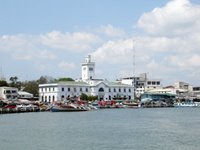 Welcoming us in Iloilo were a few colonial warehouses and the pre-war customs building. I decided to walk around the area to check out the buildings. Wow! Iloilo still had a lot of remnants of its past scattered all over the place. It would be nice to work on an urban renewal plan for Iloilo highlighting all this built heritage. I hope the HCS gets to work on it with Mayor Trenas ASAP since I feel we could replicate the Macau urban renewal success story in Iloilo!
Welcoming us in Iloilo were a few colonial warehouses and the pre-war customs building. I decided to walk around the area to check out the buildings. Wow! Iloilo still had a lot of remnants of its past scattered all over the place. It would be nice to work on an urban renewal plan for Iloilo highlighting all this built heritage. I hope the HCS gets to work on it with Mayor Trenas ASAP since I feel we could replicate the Macau urban renewal success story in Iloilo!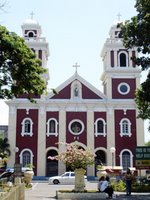 A few meters away from the port was the San Jose Church in downtown Iloilo City. The city is actually composed of several districts which include Jaro, Molo (which was the Chinatown or Parian), Villa de Arevalo (a former capital of Iloilo province which today is called as Villa for short), La Paz (most known for its batchoy), and Mandurriao.
A few meters away from the port was the San Jose Church in downtown Iloilo City. The city is actually composed of several districts which include Jaro, Molo (which was the Chinatown or Parian), Villa de Arevalo (a former capital of Iloilo province which today is called as Villa for short), La Paz (most known for its batchoy), and Mandurriao.After brunch, I took a jeep to Villa and got off near the UP Visayas campus where jeeps to Miag-ao were waiting. My next destination was a UNESCO World Heritage Site, the Church of Sto. Tomas de Villanueva.
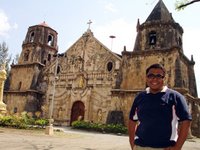 The trip took me about one hour passing through the towns of Oton (the old church of Oton was the pinnacle of religious architecture in the Philippines but was toppled by a strong earthquake in 1948), Tigbauan and Guimbal. Finally, I arrived in Miag-ao! The facade of the church was a work of art and every inch a testament to the craftsmanship of our Filipino ancestors.
The trip took me about one hour passing through the towns of Oton (the old church of Oton was the pinnacle of religious architecture in the Philippines but was toppled by a strong earthquake in 1948), Tigbauan and Guimbal. Finally, I arrived in Miag-ao! The facade of the church was a work of art and every inch a testament to the craftsmanship of our Filipino ancestors.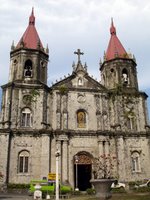 So it was back to Iloilo City to try to visit Molo, Jaro and La Paz. The church of the town after Miag-ao, San Joaquin, was another national cultural treasure. But I didn't have the luxury of time today.
So it was back to Iloilo City to try to visit Molo, Jaro and La Paz. The church of the town after Miag-ao, San Joaquin, was another national cultural treasure. But I didn't have the luxury of time today.At least Molo was along the way to downtown. So I got off at Molo to check out some churches and houses. I would say that Molo Church is a symbol of feminism because it is a shrine to female saints. The Church of Sta. Ana has on nine statues of female saints on either side of the church, one on every column. At the center retablo is Sta. Ana, mother of Mary. The houses left standing around the area were stunning as well.
With Molo done, it was off to Jaro. But traffic was moving really slow. And by 4 p.m., I was still in the public market so I decided not to push through since I could be left behind by the last ferry which left at 5:30 p.m. So I checked mail to kill time.
 Watching the sun set behind the customs building was just enchanting. On the way back, I took photos of Guimaras Island. Seeing the island, green and untouched, made me realize that the country still had hope if we took care of what was left of it.
Watching the sun set behind the customs building was just enchanting. On the way back, I took photos of Guimaras Island. Seeing the island, green and untouched, made me realize that the country still had hope if we took care of what was left of it.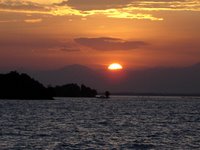 I got back in Bacolod at about 6:30 p.m. Near the cathedral was an area called manukan country, which was a cluster of restaurants ans stalls which served Bacolod's famous chicken inasal. And when in Bacolod, you must try the chicken!
I got back in Bacolod at about 6:30 p.m. Near the cathedral was an area called manukan country, which was a cluster of restaurants ans stalls which served Bacolod's famous chicken inasal. And when in Bacolod, you must try the chicken!I leave for Manila tomorrow. But I have only last stop before going home, the Paris of Negros.
Check out this Inquirer article which came out today for my two seconds of fame! Hehe!

No comments:
Post a Comment